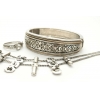|
 We are
accustomed to believe that gold is one of the precious metals to honor and
respect in every part of the world. And though we rate silver as the less
precious and thus, less expensive metal, in respect to the technique, purity
rate and alloy, the silver can cost much higher than gold. The technique and
performance commit to the cost of item since we cannot redo the filigree works
from gold. However, the strength of metal matters to make a delicate and
durable thread of silver, and we know that silver is very ductile though it is
solid. And so, the purity rate is what matter here. We are
accustomed to believe that gold is one of the precious metals to honor and
respect in every part of the world. And though we rate silver as the less
precious and thus, less expensive metal, in respect to the technique, purity
rate and alloy, the silver can cost much higher than gold. The technique and
performance commit to the cost of item since we cannot redo the filigree works
from gold. However, the strength of metal matters to make a delicate and
durable thread of silver, and we know that silver is very ductile though it is
solid. And so, the purity rate is what matter here.
What is
purity rate?
The
jewelers do not tend to use pure noble metals to make jewelry since they have
particular drawbacks. So, silver is too subtle metal and some copper is added
to silver to have a more durable and stronger alloy. The percentage of copper
in silver is what defines the purity of silver and thus, its purity rate.
Silver is rarely strengthened by other metals as aluminum, cadmium, nickel and
zinc. And copper is the basic material to add to silver to acquire silver
alloy. And yet, the silver of the higher purity with minimum copper addition
has an incredible white color while the lowest purity rate shows the yellowish
shade. Yet, the most expensive silver is acquired when cadmium is added to
silver and such jewelry is appreciated much higher than that made from gold.
Most countries
refer to the metric system of metal purity rate definition when the parts of
noble metal is rated to the thousand parts of the alloy, and thus, .960 fine or
96.0% is typical for silver jewelry to be the highest rate of purity, as well
as .925, .916, .875, .800 and .750 fine. However, there are plenty silver items
in Russia which show the purity far lower than that established in the world,
namely .800 fine which is not subject to be stamped by the state standard mark
of the Russian Federation and which are sold as items from non-precious metal.
And only there, in Russia,
the silver of .720 fine is not rare which is mainly used as the solder alloy, the
material for pins, springs and other finer items. Yet, the jewelry items of
small wear in Europe are marked as .750 fine. The silver of .925. fine is appreciated
in European countries while the silver of .800 fine is more popular in France.
History
Silver
items have been marked from old times and this standard mark provides lots of
information on the jewelry. So, the jewelry items made in the older times have the
personal standard mark of the plant-manufacturer or the master. The experts
know all the standard mark samples of reputed companies. Till the year 1927 the
zolotnik standard system was exploited based upon the old Russian pound
containing 96 zolotniks where the purity rate was determined in proportion of
the precious metal to 96 parts of the alloy.
The rate of
precious metal alloys assigned for jewelry and other items is established by legislation
and guaranteed by the government, and so the items are all controlled by the
assayer and marked to show the rate and fine.
Purity rate
of jewelry
The most
delicate jewelry filigree work is made from the highest silver of .960 fine. This
silver is feasible to use to prepare the thinnest thread for the laced pattern.
No other metalhas this peculiarity. For
the purposes of strength the filigree items are often made from the alloy of
silver and cadmium which refers to the cost of jewelry since the gorgeous
silverwork can be made from this metal.
The silver of .925
fine is widely popular in the world to make jewelry and tableware. This silver is also called sterling silver to
honor the fact that a coin of one pound sterling was stamped from this silver
some time ago in the past. The alloy of .916 fine is usual to make jewelry
glazed with enamel, while the silver of .875 fine to be of the most wholesome
purity in the world for jewelry and tableware. Silver tableware is inherited in
families and besides of its peculiarity to decontaminate water and meal, it is
believed to protect the whole family from evil.
|